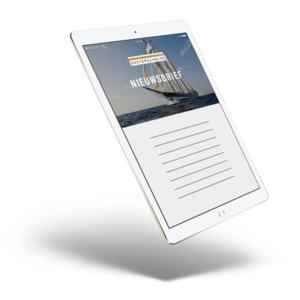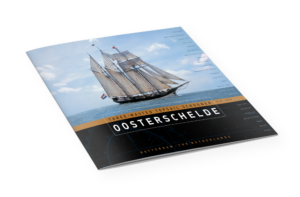03 Dec Le Maire Strait
Le Maire Strait
3 December 2013
Leo Boersen reports:
“In yesterday’s logbook Kaatje told about the speech by captain Arian when we were rounding the cape. The last part of his speech was a bit tricky: “By the way, the clock goes one hour forward now”. With the cape just behind us and both lighthouses still clearly visible, it suddenly was just before midnight, the start of the middle watch, which had to go on deck right away. The dark lines of Cape Horn were still visible for some time. There was a stiff westerly, 8 Bft, turning SSW gradually and the wind would not decrease. Just past the cape, Northeast of it, are the Barnevelts Islands, named after Johan van Oldebarnevelt. These little islands were visible in the dark for about 30 minutes after passing the Cape. On the previous trip around the world of Oosterschelde, 1996-1998, next to captain Dick van Andel there was skipper Pieter Brandjes, who, like myself, was born in the Dutch town of Barneveld. He was disappointed when I told him the above. He assumed that Cape Horn was named after the city of Hoorn -correct- and the islands after the town of Barneveld, not correct. It could have been like that, because Le Maire, to show his firmness and independence, deviating from the custom at the time to name after Saints or Christian Holy days, named the Cape ‘Cabo de Hoorn, to honour the city of Hoorn’. Having passed these islands and before entering the Le Maire Strait, there is the approach to the Beagle Channel and Ushuaia. ‘Oosterschelde’ will, during the 2nd half December, pass through here again and go to Ushuaiai, where she will start the first of her two trips to Antarctica on December 29.
‘Oosterschelde’ passed the cape doing 7-8 knots under double reef in the schoonersail and the storm jib, but the speed dropped gradually as we approached the strait between Mauritsland and Staten Island. This was caused by the strong current running here. When ‘Eendracht’ (‘Unity’, the ship of Le Maire) passed through this strait on January 25, 1616 –only named Strait Le Maire on Februari 12, 1616– in the logbooks of Schouten and Le Maire it was noted: “In the Strait we met such a hard current against us, that we could hardly overcome this with topsail speed”. They estimated the current to run with 3 knots maximum. ‘Oosterschelde’ initially was sailing with the tide -Arian estimated the speed at 3,5 to 4 knots– but later on it was against us, reducing the speed to about 5 knots, despite the heavy winds. The strait is about 15 miles wide and we sailed in the middle. During the morning, Staten Island became clearly visible, as well as the snowcapped mountains on Tierra del Fuego, a mighty and impressive view. Staten Island looks brown and is covered with woods and at first glance, is not inhabitated. By the way, Le Maire did not know ‘Statenlandt’ was an island and he named it after the Staten-Generaal (the Dutch government at the time). Only by coincidence, in March 1643, the fleet of Hendrik Brouwer discovered it actually was an island.
But there was something else captain Arian, standing in the dinghy in the glare of the Cape Horn lighthouse, mentioned to all hands on deck, still sipping their oorlam, provided to them by the ship: “ Welcome to the Atlantic!” This Atlantic immediately showed us her harsh side. Storm, cold, hail- and snow showers during all watches, with increasing winds. Under those circumstances it makes sense, that ‘Oosterschelde’ is steered by the crew only and not by the guests on board. The first group is proactive and has a steady hand. The 2nd group is slow and insecure and that does not further the voyage. Since no changes to the sails are necessary, our presence on deck is of limited use. Extra safety lines have been put in place and the harnasses have been prepared for use. When going on the deck to bring coffee or tea to the wheelhouse, or just to admire the seas, reigning on and around ‘Oosterschelde’ in all kinds of patterns and variations with an ever changing light and the permanent hauling of the winds, these are all being used. It is an impressive experience to feel and see 350 tons being lifted by its stern and then coming up again with a gracious turn. When a snow squall passes by, the wind increases to 11 Bft –as measured by mate Woody– and the waves behind are 8 sometimes 9 meters, but it feels like the Eiffeltower. We are over the continental shelf now, and for that reason there is no long heavy swell, up till now the only advantage the Atlantic has presented to us. Of course, the fact that that there is not enough length to built up waves plays a role as well. Although to be honest I must add, that both the baret of Leonard and cap of Jan -both thought to have been lost in the Pacific– were retrieved by and on the Atlantic. I spotted the baret in a whirlpool of wind near the sloop and could just prevent it was taken away by the wind and immediately made Leonard happy by giving it to him.
That things may go in a different manner, becomes clear by the fact that only a few days ago, ‘Europa’ was without any wind on this very spot, something encountered by captain Cook as well on his second voyage around the world. When entering the strait from the Atlantic, he was put back by the current.
Below deck, the ballet continues without interruption, this time the choreographer no longer being the Pacific, but the Atlantic. We now encounter short but powerful rollers, most of the time causing the ship to heel to about 30 degrees and after a number of strong rollers, suddenly in a miraculous way to become silent and thereafter everything can be heard and seen to be repeated. The hatches on the leeside have been covered with canvas to prevent leaking and that gives a kind of a twilight atmosphere and extra grandeur to the salon. In that same salon, it is business as usual. For example Wieger makes us envy with his report about his solo bicycle trip from Buenos Aires to Ushuaia in the summer of 2006-2007 for 6 months, accompanied by beautiful pictures of sunshed landscapes, the very landscape on our port side, we can not see because of the spray coming over and the clouds beyond. In between in the salon, hard thinking and bowing faces, labouring on a small poem for the imminent Sinterklaasparty o/b ‘Oosterschelde’, which one can not avoid when embarking on a historical sailing ship under a Dutch flag like ‘Oosterschelde’ at this time of the year.
Under no easy circumstances but with great determination, the schoonersail has been lowered and we now are sailing with the storm jib only, still good enough for a speed of
7 to 8 knots. We have about a day and a half to go to the 50th parallel and from thereon about 250 miles to the Falklands. If all goes well, we will be there on Saint Nicolasday, December 6. Maybe the better so, since how could Sinterklaas possibly board ‘Oosterschelde’ when she is rolling and pitching like she is doing now?
In his introduction to ‘Below the convergence’ Alain Gurney writes: “An old tradition has it, that those who have rounded Cape Horn under sail can take their afterdinner drink with one foot on the table”. If you also have crossed the polar circles under sail, you even can put both feet on the table.
This looks rather promising for Port Stanley, whereby it may be recommended, judging by what I smell and see around me, that all hands put on a fresh pair of socks, if possible after having washed their feet, maybe even with soap.”





